From Poverty to Power in Pembroke
In Illinois, a rural Black farming community shows that energy efficiency and electrification of appliances can lead to economic justice, without the need for more fossil fuel infrastructure. The program behind this success offers a template for other states to follow.
The second in a series of stories based on RMI analysis of how key US states are deploying real climate solutions. See more at State Climate Scorecards.
Azizah Ashraf-Ali was spending a lot of money on propane and wood to heat her drafty home all winter. Now, thanks to an energy efficiency and electrification pilot program, the retired schoolteacher and counselor is saving money on energy bills and is comfortable year-round.
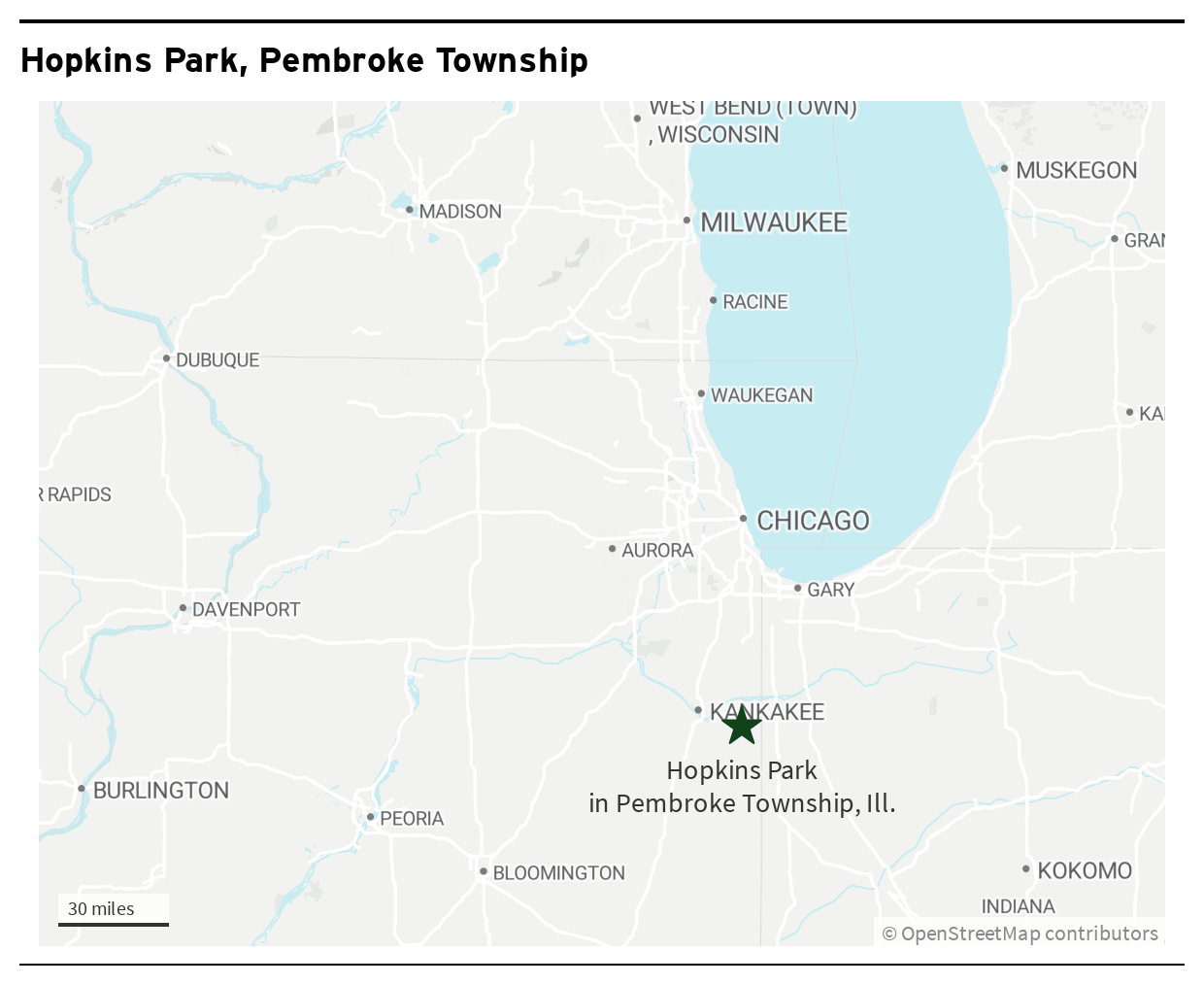
Ashraf-Ali lives in Pembroke Township, a community of just under 2,000 people in rural Illinois, 60 miles south of Chicago. Almost a quarter of the families in this historic Black farming community live below the poverty line. Pembroke and the town village, Hopkins Park, founded by formerly enslaved people, were never hooked up to a natural gas line, so for decades people have heated their homes with wood and propane.
The lack of access to gas in this rural community led Reverend Jesse Jackson and others to lobby heavily for a gas pipeline to be installed to the community in the name of economic development. The area's utility, Nicor, has proposed a plan to install that pipeline, running gas through a rare ecosystem filled with diverse wildlife.
And although the community has fought for equal access to energy services for years, there is now a group of people working on an alternative approach to deliver local homeowners the reliable energy they deserve, but via options that will cost less, improve indoor air quality, and be better for the climate.
Gas Does Not Equal Economic Justice
Lee Ringo is the energy efficiency project manager for the Community Development Corporation of Pembroke and Hopkins Park (CDC-PHP). He is excited that there are alternative technologies that can allow Pembroke to be a leader in new solutions that bring them into the future. “The Pembroke community doesn't have to choose between affordable energy and healthy air or environmental stewardship. There are clean energy alternatives to fossil fuels that can meet the community's needs, providing affordable energy, home comfort, and healthy living spaces right now.”
CDC-PHP is a nonprofit organization founded to advocate for community-based action and leadership to improve the quality of life within Pembroke Township. Working with RMI, the Midwest Building Decarbonization Coalition, ComEd, the Environmental Protection Agency, and the Department of Energy, CDC-PHP created the Pembroke-Hopkins Park Energy Efficiency Pilot (PEEP) to reduce carbon emissions, indoor air pollution, and energy costs through energy efficiency upgrades and replacing old appliances with efficient electric ones. Ten homes in Pembroke Township received energy audits.
“We found a lot of dilapidated conditions in Pembroke housing caused by years of redlining and neglect,” says Johari Cole-Kweli, who has been practicing sustainable farming in Pembroke for 30 years and is currently president of the board of CDC-PHP. Most residents heat and cook with propane and wood, and have outdated inefficient appliances and leaky drafty homes. Most of the homes also have mold and moisture problems.
Four of the homes were chosen to receive energy efficiency and appliance upgrades as part of a pilot project. “We selected the homes based on diversity of appliances and construction type,” says Ringo. “We want this pilot project to be applicable to many other areas so we wanted to prove this could work in different housing types.”
All of the homes received an average of $35,000 in home upgrades including crawlspace and attic insulation, air sealing, new hot water tanks, and electric air source heat pumps. Some of the homes also received new windows, skylights, and modern induction stoves.
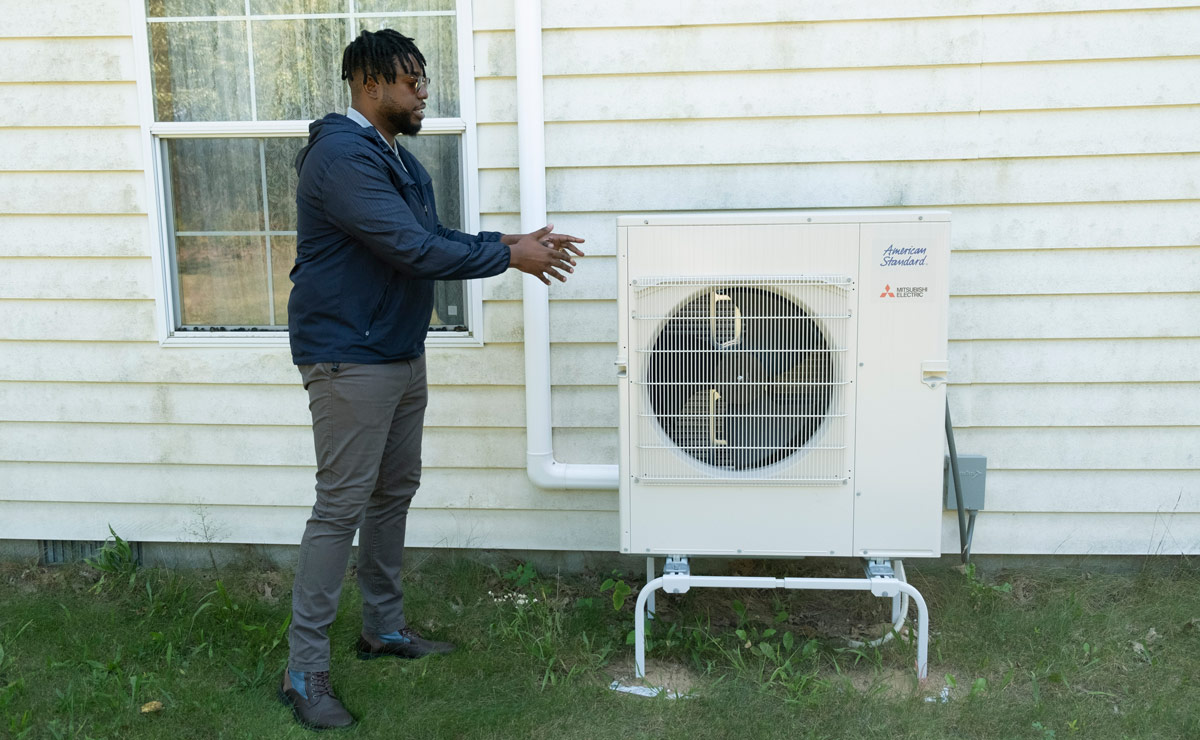
Community Outreach Is Key
The first challenge was getting the word out about the pilot project. “I thought this was going to be a breeze,” says Ringo. “We did a direct mail campaign telling people about this free program that could help them save money, and it failed completely. This community has a history of undelivered projects and manipulation.”
Ringo's grandmother was born and raised in Pembroke, so he went to her for advice. “She thought the project was amazing, and she told me that we have to do what we say we're going to do, and we have to get buy-in and get the community's trust,” he says. So they changed to a boots-on-the-ground approach, going door to door, business to business, and interacting with everyone personally.
“It's a longer route, but it's more effective,” says Cole-Kweli. “Education and engagement in the community are critical. Now the word's out and we have a lot of interest. We also delivered a high-quality project. All of our appliances are top of the line,” she adds.
Illinois Emerges as a Climate Leader
Illinois has emerged as a frontrunner on climate in many ways. According to RMI's State Climate Scorecards, the Prairie State became a climate leader with the passage of the Climate and Equitable jobs Act (CEJA), a bill that sets ambitious emissions targets and provides substantial investments in the energy transition.
The state's CEJA specifies a target of 40 percent renewable energy by 2030 and 50 percent by 2040. And the state set a nonbinding goal of getting 1 million EVs on the road by 2030, approving a $4,000 rebate for electric vehicles that will help fund charging infrastructure.
“Illinois is not just an environmental leader, but an environmental justice leader,” says Ana Sophia Mifsud, a manager at RMI working on the PEEP project. “However, Illinois still has a way to go to reach their buildings sector emissions goals. The PEEP project shows that there are ways to reduce carbon emissions from Illinois homes while focusing on environmental justice.”
Lower Costs, Better Comfort
Jumana Malikulmulk, another participant in the PEEP program, moved from Chicago to Pembroke more than 20 years ago. The 83-year-old estimates that she used to spend about $1,800 a year on propane to heat her house. She now has a state-of-the-art electric heat pump that she can use for both heating and cooling. After participating in the PEEP project, she says she felt the difference right away. “The drafts are definitely gone, and there are less bugs. And it will be great to see how much lower my bills are.” Makilmulk also did not have any cooling in her home before. “I now run the cooler a bit and it cools the room so well I can sleep through the night even in the crazy humidity.” she says.
Ashraf-Ali moved to Pembroke from the city in 2010 for the peace and quiet and built her home in 2014. Her one-story two-bedroom home sits next to her gardens where she grows tomatoes, green peppers, corn, sweet potatoes, okra, cabbage, and string beans.
After the upgrades, the air leakage in her house decreased by 30 percent. The PEEP project not only provided her with a new porch roof, seven new windows, and a heat pump, but also changed out her propane stove for an electric induction stove. “I love the induction stove,” she says. “It cooks much faster, I can make my tea in an instant.” And even with the addition of the electric stove, heat pump, and air conditioning, her electric bills have decreased. “I used to pay about $60 or $70 a month for electricity, and my last bill was only $45,” she explains.
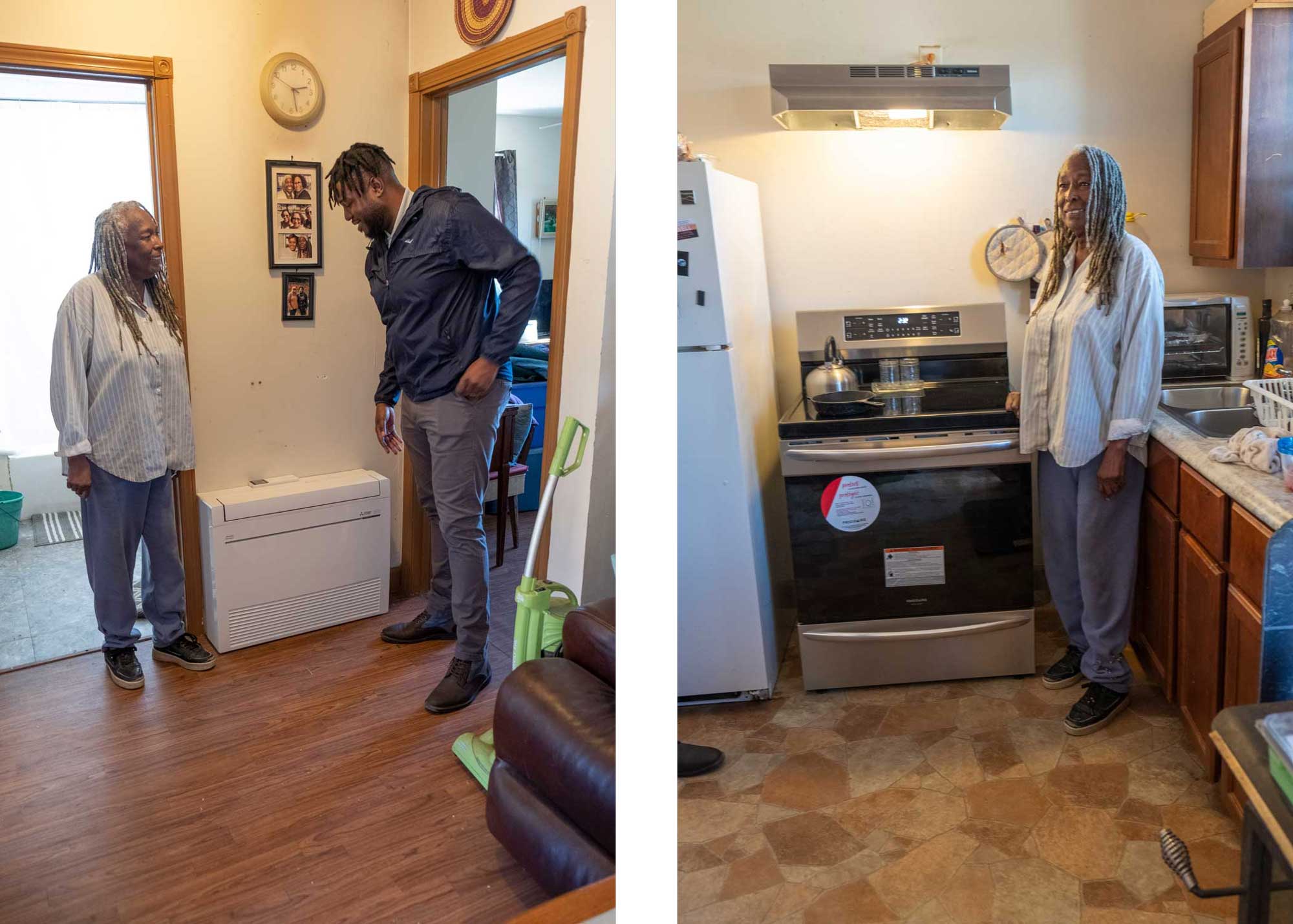
Ashraf-Ali is also not paying for propane anymore. And since she is now in an all-electric house, she is in a lower electricity rate from her utility, ComEd.
Prior to the PEEP program, most residents were paying, on average, between $350 and $500 per month on energy bills and an average of $650 two to three times a year to fill up their propane tanks. Ringo will be collecting data from the homes in the project to analyze energy savings, carbon savings, and improvements in indoor air quality.
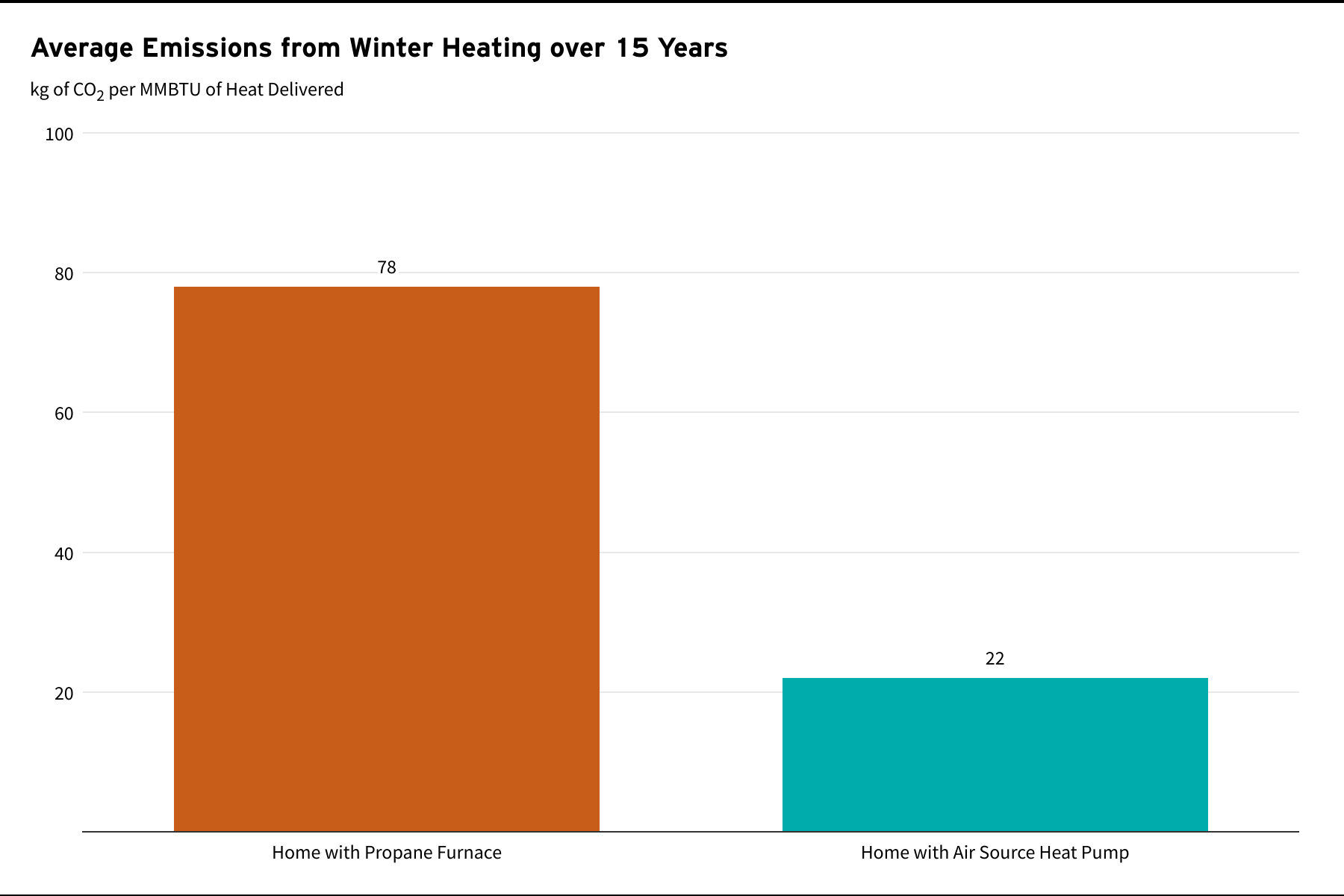
However, data from Rewiring America estimates that homes in Kankakee County (Pembroke’s county) could save up to $317 per year if their space heating is electrified. These upgrades will also reduce emissions. RMI estimates that the installation of air source heat pumps into homes reduces the home’s emissions by up to 70 percent per unit of heat delivered. And Pembroke homes should have even greater reduced emissions when including the insulation, stove, and water heater upgrades. Additionally, the heat pump will continue to be cleaner as the Illinois grid adopts more renewables. And without gas emissions, indoor air quality should be greatly improved.
PEEP Shows and More
The CDC-PHP currently has a proposal to expand the project. PEEP 2.0 will address homes that did not qualify for the first pilot project due to too much mold or exorbitant costs for construction that was needed to get the homes up to par to be able to retrofit them. PEEP 2.0 will provide funds to improve the homes beforehand to get them to qualify or even replace the entire home.
“And we aren’t just going to expand the project in terms of more homes,” says Cole-Kweli. “But also provide more community-wide energy support, awareness, education, and training.” These include what Ringo is calling PEEP shows, educational pop-ups that will provide information to community members about the importance of energy efficiency and the benefits of a clean energy transition.

A Model for Rural America
The PEEP project can have far-reaching impacts, beyond Hopkins Park and Pembroke Township. “There are many communities throughout the United States that are not connected to gas infrastructure, that rely on inefficient appliances and fuel delivery from propane, which is expensive, dirty, inconvenient, and bad for the environment,” says Mifsud. “Here is a solution that exists for them, but sometimes it’s hard for people to see that this is a solution if they can’t see themselves reflected in the examples. It’s not as useful to them to see a heat pump installed in Chicago, they want to know that it works for their type of housing, for their community.”
Cole-Kweli couldn’t agree more. “We’re trying to make the project relatable and transferrable to every other rural community,” she says. “We’re finding the best approaches to reaching people in disenfranchised communities, getting a good glance into what their initial issues are, and addressing those issues up front.” CDC-PHP is also working with utility boards to figure out how to lower the costs, and helping people find and qualify for the rebates and incentives.
“For too long, Pembroke Township has had too few energy options in this beautiful corner of the state with history as rich as its soil,” Ringo says. The PEEP project is giving people alternatives and demonstrating that they can work for them. And it’s an alternative that can reduce costs, improve health, and make people more comfortable without doubling down on fossil fuel infrastructure.
Malikulmulk praises not only the upgrades her house received, but the people behind them. “My favorite part of the PEEP program is the people that I’ve met and the fact that they know what they’re doing. They’re courteous enough to listen to what your problems are and are able to help you resolve the issues,” she says. “And my house is now so comfortable, the project gets an A+ from me.”
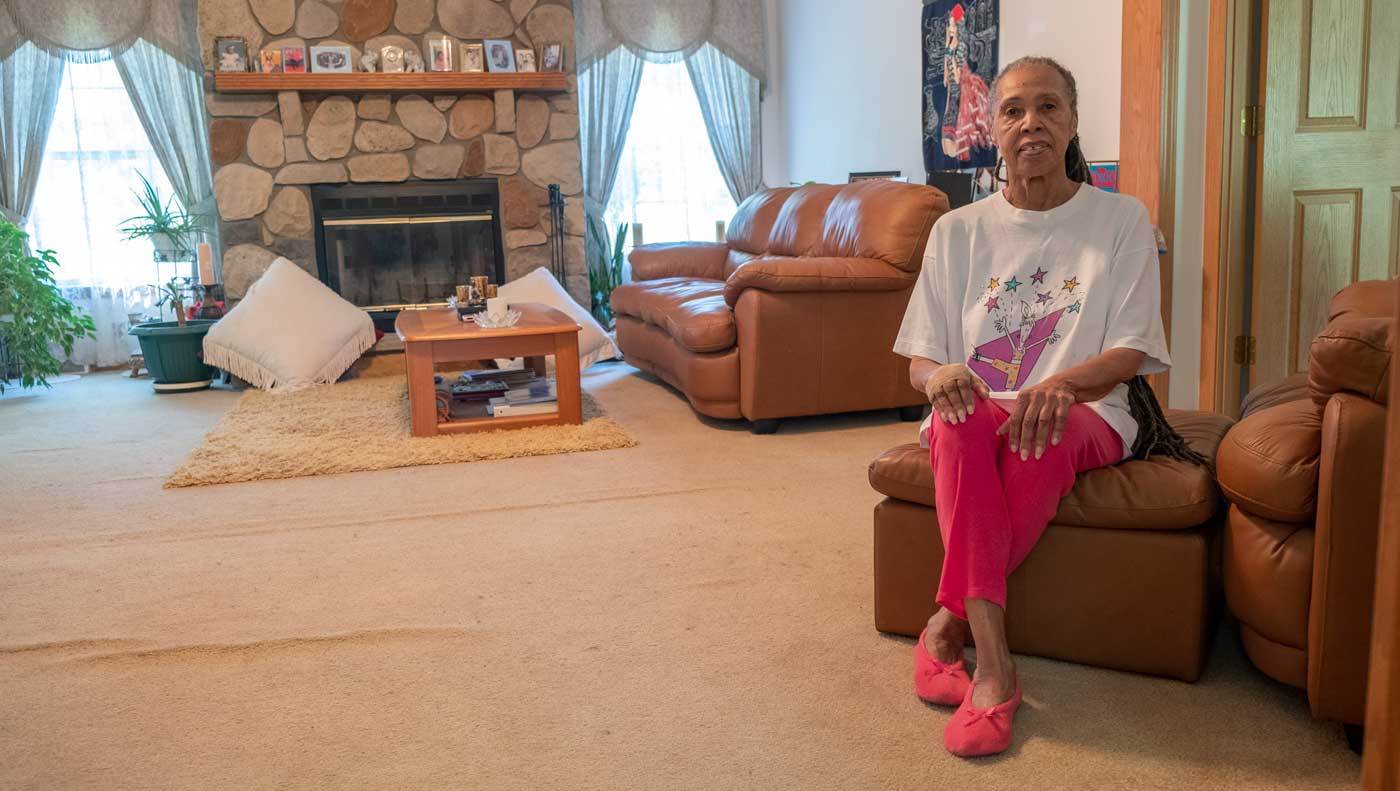 Jumana Malikulmulk in her upgraded home.
Jumana Malikulmulk in her upgraded home.
“My house is now so comfortable, the project gets an A+ from me.”
Jumana Malikulmulk says she noticed a difference right away after her skylights were replaced, attic and crawlspace were insulated, and she had an air source heat pump installed at her house through the PEEP program.